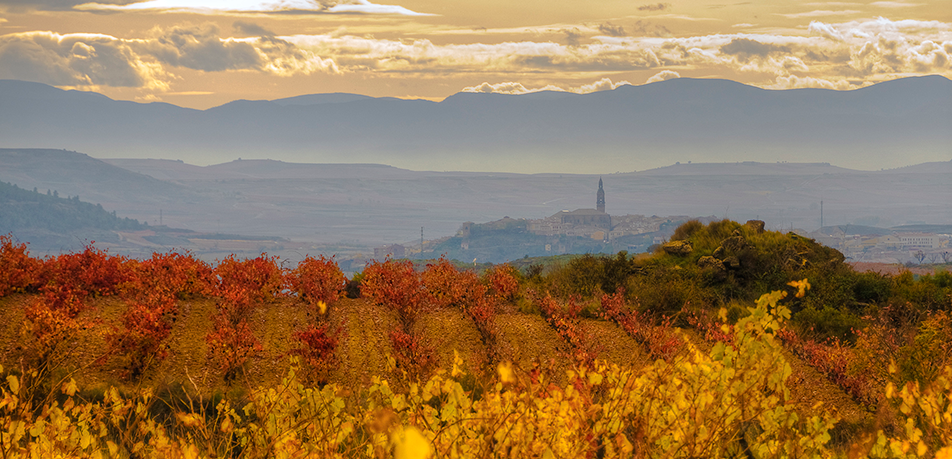DOC RIOJA

Familia Torres is deeply committed to this appellation of origin, especially in Labastida. Given everything Rioja has to offer, it needs no justification—Rioja is a reason in and of itself. Much has been written about the unique characteristics and virtues of Rioja wines, about the soils and winegrowing methods, and the region’s appeal to visitors.
Old and new blend harmoniously in Rioja where wine unites and articulates the defining idiosyncrasies of a region devoted to its culture and the multifaceted social dimension that enlivens its homes and streets.
[[{"fid":"18767","view_mode":"default","fields":{"format":"default","alignment":"","field_file_image_alt_text[und][0][value]":false,"field_file_image_title_text[und][0][value]":false},"type":"media","field_deltas":{"1":{"format":"default","alignment":"","field_file_image_alt_text[und][0][value]":false,"field_file_image_title_text[und][0][value]":false}},"link_text":null,"attributes":{"height":388,"width":638,"style":"height: 304px; width: 500px;","class":"media-element file-default","data-delta":"1"}}]]
Rioja is a treat for ecologically minded travelers. From the highlands of the fertile Ebro Valley, the region follows tributaries that nourish an abundance of vineyards, fields and fruit groves all the way to Aldeanueva de Ebro in the lowlands.
Like a life-giving deity, the Ebro river divides Rioja into three subzones, each with their own identity, while making them part of a whole: Rioja Alta, located upriver, has a distinctly northern climate and fertile winegrowing soils. Geographically speaking, Rioja Alavesa is the most interesting. Located at a higher elevation, it has steeper slopes and lies behind the Cantabrian mountain range, which protects it from cold winds and moderates the air temperature. Labastida, the town where Familia Torres has committed the new project, is situated here.
Rioja Baja has a warmer climate due to drier and more open terrain. An interesting fact worth mentioning is that the Winkler line, which separates northern and Mediterranean climate conditions, runs through Haro.
[[{"fid":"18768","view_mode":"default","fields":{"format":"default","alignment":"","field_file_image_alt_text[und][0][value]":false,"field_file_image_title_text[und][0][value]":false},"type":"media","field_deltas":{"2":{"format":"default","alignment":"","field_file_image_alt_text[und][0][value]":false,"field_file_image_title_text[und][0][value]":false}},"link_text":null,"attributes":{"height":553,"width":886,"style":"height: 312px; width: 500px;","class":"media-element file-default","data-delta":"2"}}]]
Familia Torres vineyard in Rioja Alavesa (municipality of Labastida, 1271 m)
Every subzone is a world of distinctive nuances, which you can explore on one of the many wine tourism routes organized by the appellations Regulatory Council. History and archaeology enthusiasts can get a firsthand look at how wine culture has interwoven the idiosyncrasies of a society that knows and celebrates its roots. The region’s many cultural spaces make consistent references to wine and vine, and it is common for many wineries to have their own museums and historical archives.
To truly understand the local and international prestige of Rioja wines, we have to go back in time to the latter third of the 19th century. A new French-inspired Rioja style was gaining ground as the region moved away from the rustic wines that had predominated thus far.
For wine lovers with hedonistic souls and perennial appetites, the streets are the place to be for wine and food. Tapas culture is an integral part of local life in Rioja. Take an evening stroll through the streets of any town, and you'll get lost in the liveliness and simple joys of sharing wine and food with people you love. Pure life. Eating and drinking are closely connected here, a lovely matter-of-fact pairing that does away with lofty jargon to focus on feeding the soul.
La Carbonera project, by Familia Torres. Las Pisadas
Amid Rioja Alavesa vineyards that are over 70 years old, we craft Las Pisadas at our new project La Carbonera, not far from the town of Labastida.
Opaque, dark cherry red in color, Las Pisadas is full of exquisite fruit (raspberry jam) with delicate notes of dried fruit (dates) and spicy undertones (clove). Flavorful and warm in the mouth, it unfolds sensually and very pleasantly across the palate.
“The wine is an elegant embodiment of typicity, terroir and concentration.” (Julio Carreter, enologist at La Carbonera)
[[{"fid":"18770","view_mode":"default","fields":{"format":"default","alignment":"","field_file_image_alt_text[und][0][value]":false,"field_file_image_title_text[und][0][value]":false},"type":"media","field_deltas":{"5":{"format":"default","alignment":"","field_file_image_alt_text[und][0][value]":false,"field_file_image_title_text[und][0][value]":false}},"link_text":null,"attributes":{"height":1181,"width":591,"style":"height: 500px; width: 250px;","class":"media-element file-default","data-delta":"5"}}]]
Rioja is home to seekers of beauty and curious minds fond of contrasts. It revolves around wine, bringing us iconic architecture at the vanguard of modernity while preserving a quiet way of life inextricably linked to the land and a rich tangible heritage for visitors to enjoy.
Taking a break is important, and the region is dotted with places for relaxing farm stays to replenish body and soul before embarking on a new day in this long and fertile valley. Rioja is more than the prestige of its wines; it is a vibrant place with a rich history waiting to be experienced, again and again.
